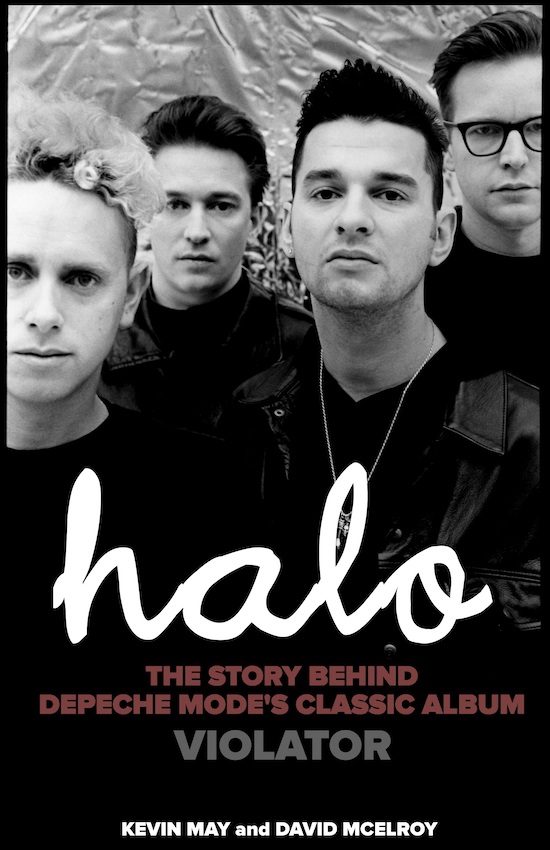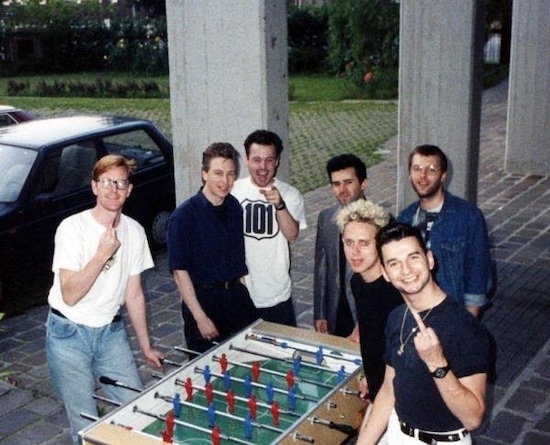Logic Studio team, Milan, May 1989 – L to R: Andy Fletcher, Alan Wilder, Daryl Bamonte, Roberto Baldi (engineer), Martin Gore, David Gahan, Flood (producer)… (Credit: Roberto Baldi)
“Depeche fans are affable, a happy group of people… yet suddenly it was a mob! But, you know, it was really just people trying to get to the band.”
Los Angeles, March 1990. California’s largest city features strongly in the Depeche Mode story.
After the first two singles from Violator – ‘Personal Jesus’ and ‘Enjoy The Silence’ – had successfully managed to whip fans into a frenzy, and also stir the often cynical loins of critics, attention turned to how the band might capitalise on an increasing sense of anticipation and excitement ahead of the release of ‘Violator’.
In almost every country where Depeche had a significant fan base, and by 1990 this figure would easily have been pushing into the dozens, preparing for the release of a new album would follow a familiar pattern for the band. A single or two, as was the case with Violator, would have preceded the launch of the album, often with the first song hitting the airwaves as far as six to eight months before the album was released. Each single would have its associated radio and TV play, with the latter more often than not featuring an accompanying lip-synced performance to a backing track.
Interestingly, despite their respective high chart positions (13 and 6), neither the release of ‘Personal Jesus’ or ‘Enjoy The Silence’ led to an appearance by the band on their home turf’s high-profile weekly music TV show, Top Of The Pops. Still, such appearances would be planned weeks in advance and would often mean the band and their entourage would head off to a European city somewhere to perform the song and cram in countless numbers of interviews with local media.
The merry-go-round of PAs (personal appearances) and interviews ensured the band were front and centre in as many markets and channels as possible during the critical single-buying period.
Innumerable features would appear in the niche music newspapers (such as the NME in the UK), plus many of the mainstream music and entertainment magazines were on-board by then, such as Rolling Stone and Q.
Despite their general apathy towards parts of the media, especially in the UK where the music press had often been far from kind in its coverage of the band, Depeche had a system that was exhausting, yet successful. The band would rarely conduct interviews as a four-piece, primarily to save time rather than (at this stage) because they’d fallen out with one another. Dave Gahan and Alan Wilder or Martin Gore and Andy Fletcher, for example, would do the rounds of the radio and TV stations, magazines and newspapers to espouse the virtues of their latest public output. And then they would move on to the next city and the process would start again.
In 1990 however, the American marketplace for promoting and selling records was one where it was generally still extremely difficult to do so efficiently and effectively.
Until Violator, much of Depeche’s exposure to US audiences had come from its commitment to playing shows across the country and plugging those appearances close to the date of each performance.
They were, in many respects, still seen as an underground band in the eyes of those in the mainstream music industry when it came to an album launch, relying on radio play from local or university radio stations.
The ‘Music For The Masses Tour’ triggered the beginnings of a rethink as to how Depeche would have to tackle the US from a promotional perspective for albums in the future.

The band had played some 40 shows in North America over two legs in late-1987 and mid-1988, culminating in the 101st show at the Pasadena Rose Bowl in June, but also taking in destinations as diverse as Austin in Texas, Salt Lake City in Utah and Iowa’s Cedar Rapids.
The touring and media schedule had worked, pushing the band towards the edges of its then cult status, as many of those in the mainstream media woke up and realised that another group of four young lads from Britain were causing a hell of a stir on college campuses.
The triumph of the Rose Bowl gig and the fever surrounding the release of the subsequent 101 movie and live record had shown that not only was there an enormous fan base in the US but it was one that could help propel Depeche even further into the consciousness of the country’s mainstream record-buying public. But in many respects, Depeche were in uncharted territory, as was its UK label Mute Records.
The buzz amongst fans following the releases of ‘Personal Jesus’ and ‘Enjoy The Silence’, coupled with a confidence in the Depeche camp knowing that the Violator album was clearly a massive step up in its creative output, showed there was the potential for something big – bigger than Pasadena and 101 – to happen. Touring relentlessly for years and working the local radio circuit in the US is one thing; how to launch an album on the national stage, in a country as diverse and big as America, is another matter entirely.
The band’s US label Sire came up with a plan. They and Mute joined up with the Los Angeles radio station K-ROQ, long-time Depeche Mode supporters, and announced a Violator signing session at the record shop The Wherehouse which was based at 3rd and La Cienega in Los Angeles.
Prior to the signing, Martin was interviewed by telephone on the show Request Video. The host Jim ‘The Poorman’ Trenton asked Gore if he was aware that it had been predicted that a crowd of ten thousand people would attend the event.
Gore replied, saying, “I think everybody is getting too hyped up about it. It’s going to be really disappointing.” Events proved Martin wrong by quite a distance.
The event was scheduled to take place on 20 March 1990 and was due to start around 9pm. The demand for anything Depeche Mode related was so high that fans began camping out the night before the event and by 8pm on March 20, there were indeed around 10,000 fans queuing at the store as had been predicted. That number would only increase as the start time approached.
It is worth noting that by this time in their career, Depeche Mode were an established band, all aged in their late twenties or early thirties. They were not a British invasion era Beatles causing a teen frenzy, nor were they at the stage in their career Duran Duran found themselves when they first went to America and were besieged by the teen hordes.
Depeche Mode’s audience had grown up with the band and could be considered to be more mature than the armies of teenagers who were best known for following around various bands in a state of frenzy. The type of audience Depeche Mode had made the events that unfolded at The Wherehouse all the more remarkable.
Here was a band who were still far from critically acclaimed at home and who had become huge in America with little, if any, mainstream support. Despite these things, people were camping out overnight just to get an autograph and thousands, yes thousands, more people joined those campers the next day in the hope of meeting their heroes. It seems almost impossible to believe and, had the event not received widespread coverage after its conclusion, would anyone really accept that Depeche Mode had created such a frenzy that their fans went on the rampage?
The event was broadcast live on KROQ with Richard Blade interviewing the band before the doors opened at 9pm. It was already obvious that the size of the crowd outside the store had far exceeded all expectations. Gahan told Richard that he was “very moved” by the sheer volume of fans at The Wherehouse adding that he hadn’t expected many people to turn up at all.
Jim Trenton was present too with a Request Video camera crew and their footage shows just how frantic events became as the evening proceeded. Jim manages to interview the band too with Gahan telling him that it was “really flattering” that so many people had come to see Depeche Mode. He added that he’d heard that around 17,000 people were there.
The doors opened at 9pm and fans started filing in, offering anything Depeche Mode related to the band for them to sign. As well as sundry Violator related items, footage of the event shows a diverse range of Depeche Mode items including the band’s least-loved single ‘It’s Called A Heart’. Ever the professionals, they even signed that.
It quickly became apparent that things were starting to go wrong outside The Wherehouse. Fans were being crushed against the store’s windows and there were growing concerns for everyone’s safety. KROQ was broadcasting live throughout the event and they started passing on police warnings to their listeners.
Blade first announced that he had heard from the police that fans were to “keep it mellow or the cops will close it down.” He later advised listeners that “things are pretty serious” and he sounds genuinely worried on the broadcast.
Only one hour into the three-hour event, Depeche Mode were forced to leave the building due to police safety concerns. Blade announced the end of the event, warning fans that he had been told that “If people do not leave, they are going to jail.” Depeche Mode were smuggled out of the store into waiting limousines and they left.
Halo: The Violator Book by David McElroy and Kevin May is published by Grosvenor House Publishing


